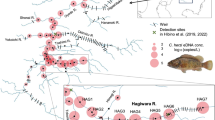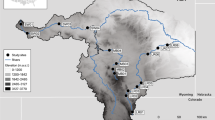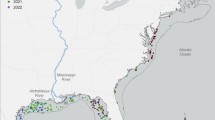Abstract
Species invasions can alter food web structure and change ecosystem-level functioning, but it is often unclear how these invasions may affect the life history of native species. The Lake Sturgeon (Acipenser fulvescens), a large long-lived native fish species in the Great Lakes, has increased in abundance in the lower Niagara River and nearby Lake Ontario during a period of invasive species-induced ecosystem change precipitated most recently by Dreissenid mussels (Driessena polymorpha and Driessena bugensis) and Round Goby (Neogobius melanostomus). Material taken from cross-sections of archived pectoral spines from Niagara River Lake Sturgeon captured in 1998–2000 and 2010–2012 were analyzed for stable isotopes across discrete growth zones to provide an ontogenetic assessment of diet, and diet analysis of Lake Sturgeon captured in 2014 was conducted to assess the contribution of invasive prey. Round Goby was the most important Lake Sturgeon prey item (86% by weight) in 2014, which corroborated results of δ15N and δ13C. Lake Sturgeon captured after the invasion of Round Goby exhibited ontogenetic changes in δ15N that differed from pre-Round Goby patterns, though this effect was weaker for δ13C. Values of δ15N from spine growth zones indicated non-linear increases in trophic position with age and increased rate of δ15N enrichment after the Round Goby invasion. We conclude that Round Goby establishment in western Lake Ontario changed the feeding ecology of Lake Sturgeon, which may have a positive effect on population growth for this native species.



Similar content being viewed by others
References
Balshine S, Verma A, Chant V, Theysmeyer T (2005) Competitive interactions between round gobies and logperch. J Great Lakes Res 31:68–77
Barbiero RP, Tuchman ML (2004) Changes in the crustacean communities of Lakes Michigan, Huron, and Erie following the invasion of the predatory cladoceran Bythotrephes longimanus. Can J Fish Aquat Sci 61:2111–2125
Barton DR, Johnson RA, Campbell L, Petruniak J, Patterson M (2005) Effects of round gobies (Neogobius melanostomus) on dreissenid mussels and other invertebrates in eastern Lake Erie, 2002–2004. J Great Lakes Res 31:252–261
Biesinger Z, Gorsky D, Jacobs GR, Sweka JA, Webb MAH, Talbott M (2014) Population assessment of Lake Sturgeon in the lower Niagara River. In: New York State Department of Environmental Conservation 2013 Annual Report to the Great lakes Fishery Commission’s Lake Ontario Committee, Windsor, Ontario, 26–27 March 2014
Bligh EG, Dyer WJ (1959) A rapid method of total lipid extraction and purification. Can J Biochem Physiol 37:911–917
Bowen SH (1996) Quantitative description of diet. In: Murphy BR, Willis DW (eds) Fisheries techniques, 2nd edn. American Fisheries Society, Bethesda, pp 513–532
Bruch RM, Campana SE, Davis-Foust SL, Hansen MJ, Janssen J (2009) Lake sturgeon age validation using bomb radiocarbon and known-age fish. Trans Am Fish Soc 138:361–372
Burnham KP, Anderson DR (2002) Model selection and multimodel inference: a practical information-theoretic approach, 2nd edn. Springer, New York
Capps KA, Flecker AS (2013) Invasive aquarium fish transform ecosystem nutrient dynamics. Proc R Soc B Biol Sci 280:20131520
Carlson D (1995) Lake Sturgeon waters and fisheries in New York State. J Great Lakes Res 21(1):35–41
Chalupnicki MA, Dittman DE, Carlson DM (2011) Distribution of Lake Sturgeon in New York: 11 years of restoration management. Am Midl Nat 165:364–371
Crane DP, Einhouse DW (2016) Changes in growth and diet of smallmouth bass following invasion of Lake Erie by the round goby. J Great Lakes Res 42(2):405–412
DeVries RJ, Schramm HL (2015) Similarities and differences in 13C and 15N stable isotope ratios in two non-lethal tissue types from shovelnose sturgeon Scaphirhynchus platorynchus (Rafinesque, 1820). J Appl Ichthyol 31:474–478
Dorcas ME, Willson JD, Reed RN, Snow RW, Rochford MR, Miller MA, Meshaka WE, Andreadis PT, Mazzotti FJ, Romagosa CM, Hart KM (2012) Severe mammal declines coincide with proliferation of invasive Burmese pythons in Everglades National Park. Proc Natl A Sci USA 109:2418–2422
Ellis BK, Stanford JA, Goodman D, Stafford CP, Gustafson DL, Beauchamp DA, Chess DW, Craft JA, Deleray MA, Hansen BS (2011) Long-term effects of a trophic cascade in a large lake ecosystem. Proc Natl A Sci USA 108:1070–1075
Estrada JA, Rice AN, Natanson LJ, Skomal GB (2006) Use of isotopic analysis of vertebrae in reconstructing ontogenetic feeding ecology in white sharks. Ecology 87:829–834
Fry B (1991) Stable isotope diagrams of freshwater food webs. Ecology 72:2293–2297
Haley N (1998) A gastric lavage technique for characterizing diets of sturgeons. N Am J Fish Manage 18:978–981
He JX, Ebener MP, Riley SC, Cottrill A, Kowalski A, Koproski S, Mohr L, Johnson JE (2012) Lake Trout status in the main basin of Lake Huron, 1973–2010. N Am J Fish Manag 32:402–412
Hecky RE, Smith RE, Barton DR, Guildford SJ, Taylor WD, Charlton MN, Howel T (2004) The nearshore phosphorus shunt: a consequence of ecosystem engineering by dreissenids in the Laurentian Great Lakes. Can J Fish Aquat Sci 61(7):1285–1293
Higgins SN, Vander Zanden MJ (2010) What a difference a species makes: a meta-analysis of dreissenid mussel impacts on freshwater ecosystems. Ecol Monogr 80:179–196
Hobson KA, Clark RG (1992) Assessing avian diets using stable isotopes I: turnover of 13C in tissues. Condor 1992:181–188
Hughes TC, Lowie CE, Haynes JM (2005) Age, growth, relative abundance, and scuba capture of a new or recovering spawning population of lake sturgeon in the lower Niagara River, New York. N Am J Fish Manag 25:1263–1272
Hutchings JA (1993) Adaptive life histories effected by age-specific survival and growth rate. Ecology 74(3):673–684
Jackson JR, VanDeValk AJ, Brooking TE, VanKeeken OA, Rudstam LG (2002) Growth and feeding dynamics of lake sturgeon, Acipenser fulvescens, in Oneida Lake, New York: results from the first five years of a restoration program. J Appl Ichthyol 18:439–443
Jacobs GR, Madenjian CP, Bunnell DB, Holuszko JD (2010) Diet of lake trout and burbot in northern Lake Michigan during spring: evidence of ecological interaction. J Great Lakes Res 36:312–317
Janssen J, Jude DJ (2001) Recruitment failure of mottled sculpin Cottus bairdi in Calumet Harbor, Southern Lake Michigan, Induced by the newly introduced Round Goby Neogobius melanostomus. J Great Lakes Res 27:319–328
Johnson TB, Bunnell DB, Knight CT (2005) A potential new energy pathway in central Lake Erie: the Round Goby connection. J Great Lakes Res 31:238–251
Kelly MH, Hagar WG, Jardine TD, Cunjak RA (2006) Nonlethal sampling of sunfish and slimy sculpin for stable isotope analysis: how scale and fin tissue compare with muscle tissue. N Am J Fish Manag 26:921–925
Kim SL, Tinker MT, Estes JA, Koch PL (2012) Ontogenetic and among-individual variation in foraging strategies of northeast pacific white sharks based on stable isotope analysis. PLoS ONE 7:e45068. doi:10.1371/journal.pone.0045068
King RB, Ray JM, Stanford KM (2006) Gorging on gobies: beneficial effects of alien prey on a threatened vertebrate. Can J Zool 84:108–115
Krueger CC, Perkins DL, Mills EL, Marsden JE (1995) Predation by alewives on lake trout fry in Lake Ontario: role of an exotic species in preventing restoration of a native species. International conference on restoration of Lake Trout in the Laurentian Great Lakes 21, Supplement 1:458–469
Lugendo BR, Nagelkerken I, Van Der Velde G, Mgaya YD (2006) The importance of mangroves, mud and sand flats, and seagrass beds as feeding areas for juvenile fishes in Chwaka Bay, Zanzibar: gut content and stable isotope analyses. J Fish Biol 69(6):1639–1661
Madenjian CP, O’Gorman R, Bunnell DB, Argyle RL, Roseman EF, Warner DM, Stockwell JD, Stapanian MA (2008) Adverse effects of alewives on Laurentian Great Lakes fish communities. N Am J Fish Manag 28:263–282
Madenjian CP, Stapanian M, Witzel L, Einhouse D, Pothoven S, Whitford H (2011) Evidence for predatory control of the invasive Round Goby. Biol Invasions 13:987–1002
Madenjian CP, Rutherford ES, Stow CA, Roseman EF, He JX (2013) Trophic Shift, Not Collapse. Environ Sci Technol 47:11915–11916
Mendes S, Newton J, Reid R, Zuur A, Pierce G (2007) Stable carbon and nitrogen isotope ratio profiling of sperm whale teeth reveals ontogenetic movements and trophic ecology. Oecologia 151:605–615
Miller MA, Holey ME (1992) Diets of Lake Trout inhabiting nearshore and offshore Lake Michigan environments. J Great Lakes Res 18:51–60
Mills EL, Leach JH, Carlton JT, Secor CL (1993) Exotic species in the Great Lakes: a history of biotic crises and anthropogenic introductions. J Great Lakes Res 19:1–54
Nalepa TF, Fanslow DL, Lang GA (2009) Transformation of the offshore benthic community in Lake Michigan: recent shift from the native amphipod Diporeia spp. To the invasive mussel Dreissena rostriformis bugensis. Freshw Biol 54:466–479
Nilo P, Tremblay S, Bolon A, Dodson J, Dumont P, Fortin R (2006) Feeding ecology of juvenile lake sturgeon in the St. Lawrence River System. Trans Am Fish Soc 135:1044–1055
Olson MH (1996) Ontogenetic niche shifts in largemouth bass: variability and consequences for first-year growth. Ecology 77:179–190
O'Gorman R, Elrod JH, Owens RW, Schneider CP, Eckert TH, Lantry BF (2000) Shifts in depth distributions of alewives, rainbow smelt, and age-2 lake trout in southern Lake Ontario following establishment of dreissenids. Trans Am Fish Soc 129(5):1096–1106
Ozersky T, Evans DO, Barton DR (2012) Invasive mussels alter the littoral food web of a large lake: stable isotopes reveal drastic shifts in sources and flow of energy. PLoS ONE 7:e51249
Paterson G, Rush SA, Arts MT, Drouillard KG, Haffner GD, Johnson TB, Lantry BF, Hebert CE, McGoldrick DJ, Backus SM, Fisk AT (2014) Ecological tracers reveal resource convergence among prey fish species in a large lake ecosystem. Freshw Biol 59:2150–2161
Perga ME, Gerdeaux D (2003) Using the δ13C and δ15N of whitefish scales for retrospective ecological studies: changes in isotope signatures during the restoration of Lake Geneva, 1980–2001. J Fish Biol 63:1197–1207
Peterson D, Vecsei P, Jennings C (2007) Ecology and biology of the Lake Sturgeon: a synthesis of current knowledge of a threatened North American Acipenseridae. Rev Fish Biol Fish 17:59–76. doi:10.1007/s11160-006-9018-6
Pinheiro J, Bates D, DebRoy S, Sarkar D, R Core Team (2015) nlme: linear and nonlinear mixed effects models. R package version 3.1-119. http://CRAN.R-project.org/package=nlme
Post DM (2002) Using stable isotopes to estimate trophic position: models, methods, and assumptions. Ecology 83:703–718
Post DM (2003) Individual variation in the timing of ontogenetic niche shifts in largemouth bass. Ecology 84:1298–1310
Pothoven SA, Madenjian CP (2008) Changes in consumption by alewives and lake whitefish after dreissenid mussel invasions in Lakes Michigan and Huron. N Am J Fish Manag 28:308–320
R Core Team (2016) R: a language and environment for statistical computing. R Foundation for Statistical Computing, Vienna. http://www.R-project.org/
Steinhart GB, Stein RA, Marschall EA (2004a) High growth rate of young-of-the-year smallmouth bass in Lake Erie: a result of the Round Goby invasion? J Great Lakes Res 30:381–389
Steinhart GB, Marschall EA, Stein RA (2004b) Round Goby predation on smallmouth bass offspring in nests during simulated catch-and-release angling. Trans Am Fish Soc 133:121–131
Thomas MV, Haas RC (2002) Abundance, age structure, and spatial distribution of lake sturgeon, Acipenser fulvescens, in the St Clair System. J Appl Ichthyol 18(4):495–501
Turschak BA, Bootsma HA (2015) Lake Michigan trophic structure as revealed by stable C and N isotopes. J Great Lakes Res. doi:10.1016/j.jglr.2015.04.004
Turschak BA, Bunnell D, Czesny S, Höök TO, Janssen J, Warner D, Bootsma HA (2014) Nearshore energy subsidies support Lake Michigan fishes and invertebrates following major changes in food web structure. Ecology 95:1243–1252
Vander Zanden MJ, Casselman JM, Rasmussen JB (1999) Stable isotope evidence for the food web consequences of species invasions in lakes. Nature 401:464–467
Vander Zanden MJ, Shuter BJ, Lester NP, Rasmussen JB (2000) Within-and among-population variation in the trophic position of a pelagic predator, lake trout (Salvelinus namaycush). Can J Fish Aquat Sci 57(4):725–731
Vilà M, Espinar JL, Hejda M, Hulme PE, Jarošík V, Maron JL, Pergl J, Schaffner U, Sun Y, Pyšek P (2011) Ecological impacts of invasive alien plants: a meta-analysis of their effects on species, communities and ecosystems. Ecol Lett 14:702–708
Walsh MG, Dittman DE, O’Gorman R (2007) Occurrence and food habits of the Round Goby in the Profundal Zone of Southwestern Lake Ontario. J Great Lakes Res 33:83–92
Werner EE, Gilliam JF (1984) The ontogenetic niche and species interactions in size-structured populations. Annu Rev Ecol Syst 15:393–425
Acknowledgements
This manuscript was much improved by the helpful comments provided by John Sweka, Mike Millard, and four anonymous reviewers. Brian Layton, Zy Biesinger, Zeb Woiak, Jonah Withers, and many others helped assist with fieldwork and sample processing. Mention of specific products does not constitute endorsement by the U.S. Government. This study was funded by the Great Lakes Restoration Initiative. Any use of trade, product, or firm names is for descriptive purposes only and does not imply endorsement by the U.S. Government.
Author information
Authors and Affiliations
Corresponding author
Rights and permissions
About this article
Cite this article
Jacobs, G.R., Bruestle, E.L., Hussey, A. et al. Invasive species alter ontogenetic shifts in the trophic ecology of Lake Sturgeon (Acipenser fulvescens) in the Niagara River and Lake Ontario. Biol Invasions 19, 1533–1546 (2017). https://doi.org/10.1007/s10530-017-1376-6
Received:
Accepted:
Published:
Issue Date:
DOI: https://doi.org/10.1007/s10530-017-1376-6




